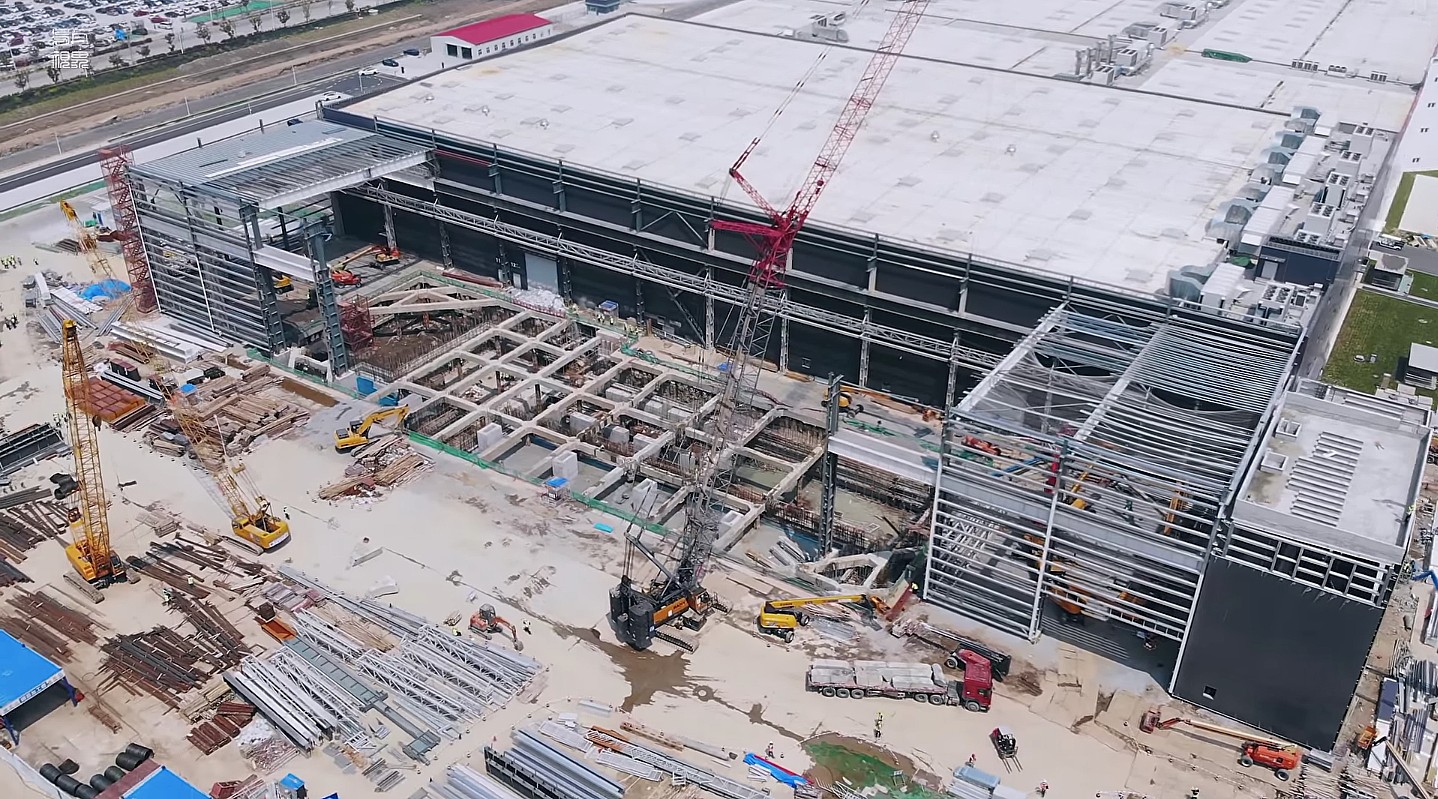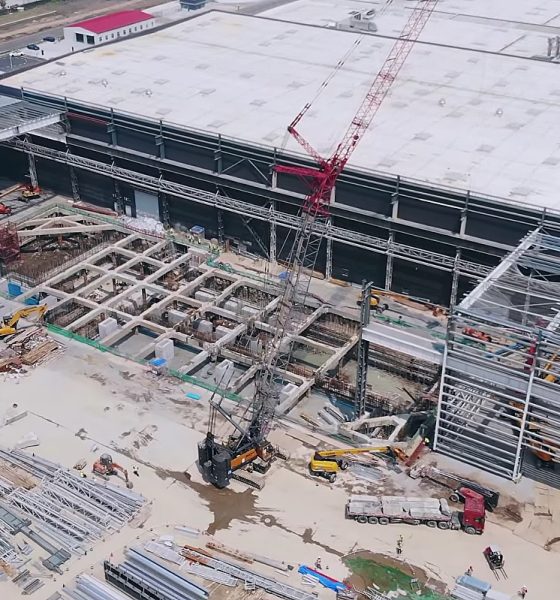

News
Tesla poised to streamline China’s Model Y production with next-gen casting machine
It appears that Tesla China is making the necessary preparations to adopt a streamlined production process for the Model Y, and perhaps even the Model 3, in Gigafactory Shanghai. Signs of such a strategy was recently revealed in a drone flyover from Tesla enthusiast Wuwa Vision, who was able to capture images of an extension to the Phase 1 building’s body stamping area.
The tail end of Gigafactory Shanghai Phase 1 is widely considered to be allotted for body stamping activities. The section was completed together with the rest of the Phase 1 building last year before the construction of the Phase 1.5 zone (a battery and powertrain assembly facility) started. Interestingly enough, the recent drone flyover shows that workers are now expanding the body stamping area.
What’s more, the construction in the body stamping workshop involves what appeared to be deep excavations, suggesting that the area will be hosting a large machine, or at least one that is larger than the ones used in the existing Model 3 line. Patents from Tesla and statements from CEO Elon Musk have hinted at such a process—one that can very well revolutionize the Model Y’s production in China.
Interestingly enough, the massive casting machine seems to be going to the Phase 1 building, which is widely believed to be allotted only for the Model 3. The reasons behind his have not been revealed by Tesla, though it’s plausible that the new casting machine may also be used for the Model 3’s production. Otherwise, this could suggest that the Model Y may begin production in the Phase 1 area, at least until Phase 2A is complete. Such a strategy would allow Tesla to start producing the crossover despite the second phase of Gigafactory 3’s buildout still ongoing.
Last July, a patent application from Tesla was published that pointed to the utilization of a giant casting machine for the production of electric vehicles. The new casting machine will feature a central hub to receive several dies that are then assembled into specific portions of a vehicle frame before being cast. The patent, in a way, reflected Elon Musk’s comments during his appearance at the Ride the Lightning podcast, where he discussed some of the manufacturing improvements in the Model Y.
“There are some manufacturing improvements for the [Model] Y. The rear underbody we’re moving to an aluminum…casting instead of a series of stamped steel and aluminum pieces. When we get the big casting machine, it’ll go from 70 parts to 1 with a significant reduction in capital expenditure on all the robots to put those parts together,” Musk said.
Musk has mentioned this large casting machine multiple times, including in his recent appearance at the Third Row Podcast, where he mentioned that the idea was amusingly inspired by a diecast Tesla Model S on his desk. Speaking about his thought process, Musk noted that he thought the Model S diecast “doesn’t cost much, and it looks pretty detailed.” Thus, he thought that it might be a good idea to “make this bigger.”
The Model Y’s giant casting machine and its results have been teased in the ongoing teardown of the vehicle from automotive veteran Sandy Munro. Compared to the Model 3, the Model Y’s casts are larger, and the body of the car seems far more refined. With such a system in place, Tesla would be able to produce the Model Y in a faster, more efficient manner. This is extremely valuable for Tesla, since the Model Y is poised to be its most high-volume vehicle yet, with Musk stating that the crossover would likely outsell the Model S, Model X, and Model 3 combined.

Elon Musk
Elon Musk confirms xAI’s purchase of five 380 MW natural gas turbines
The deal, which was confirmed by Musk on X, highlights xAI’s effort to aggressively scale its operations.

xAI, Elon Musk’s artificial intelligence startup, has purchased five additional 380 MW natural gas turbines from South Korea’s Doosan Enerbility to power its growing supercomputer clusters.
The deal, which was confirmed by Musk on X, highlights xAI’s effort to aggressively scale its operations.
xAI’s turbine deal details
News of xAI’s new turbines was shared on social media platform X, with user @SemiAnalysis_ stating that the turbines were produced by South Korea’s Doosan Enerbility. As noted in an Asian Business Daily report, Doosan Enerbility announced last October that it signed a contract to supply two 380 MW gas turbines for a major U.S. tech company. Doosan later noted in December that it secured an order for three more 380 MW gas turbines.
As per the X user, the gas turbines would power an additional 600,000+ GB200 NVL72 equivalent size cluster. This should make xAI’s facilities among the largest in the world. In a reply, Elon Musk confirmed that xAI did purchase the turbines. “True,” Musk wrote in a post on X.
xAI’s ambitions
Recent reports have indicated that xAI closed an upsized $20 billion Series E funding round, exceeding the initial $15 billion target to fuel rapid infrastructure scaling and AI product development. The funding, as per the AI startup, “will accelerate our world-leading infrastructure buildout, enable the rapid development and deployment of transformative AI products.”
The company also teased the rollout of its upcoming frontier AI model. “Looking ahead, Grok 5 is currently in training, and we are focused on launching innovative new consumer and enterprise products that harness the power of Grok, Colossus, and 𝕏 to transform how we live, work, and play,” xAI wrote in a post on its website.
Elon Musk
Elon Musk’s xAI closes upsized $20B Series E funding round
xAI announced the investment round in a post on its official website.

xAI has closed an upsized $20 billion Series E funding round, exceeding the initial $15 billion target to fuel rapid infrastructure scaling and AI product development.
xAI announced the investment round in a post on its official website.
A $20 billion Series E round
As noted by the artificial intelligence startup in its post, the Series E funding round attracted a diverse group of investors, including Valor Equity Partners, Stepstone Group, Fidelity Management & Research Company, Qatar Investment Authority, MGX, and Baron Capital Group, among others.
Strategic partners NVIDIA and Cisco Investments also continued support for building the world’s largest GPU clusters.
As xAI stated, “This financing will accelerate our world-leading infrastructure buildout, enable the rapid development and deployment of transformative AI products reaching billions of users, and fuel groundbreaking research advancing xAI’s core mission: Understanding the Universe.”
xAI’s core mission
Th Series E funding builds on xAI’s previous rounds, powering Grok advancements and massive compute expansions like the Memphis supercluster. The upsized demand reflects growing recognition of xAI’s potential in frontier AI.
xAI also highlighted several of its breakthroughs in 2025, from the buildout of Colossus I and II, which ended with over 1 million H100 GPU equivalents, and the rollout of the Grok 4 Series, Grok Voice, and Grok Imagine, among others. The company also confirmed that work is already underway to train the flagship large language model’s next iteration, Grok 5.
“Looking ahead, Grok 5 is currently in training, and we are focused on launching innovative new consumer and enterprise products that harness the power of Grok, Colossus, and 𝕏 to transform how we live, work, and play,” xAI wrote.
Investor's Corner
Tesla gets price target bump, citing growing lead in self-driving

Tesla (NASDAQ: TSLA) stock received a price target update from Pierre Ferragu of Wall Street firm New Street Research, citing the company’s growing lead in self-driving and autonomy.
On Tuesday, Ferragu bumped his price target from $520 to $600, stating that the consensus from the Consumer Electronics Show in Las Vegas was that Tesla’s lead in autonomy has been sustained, is growing, and sits at a multiple-year lead over its competitors.
CES 2026 validates Tesla’s FSD strategy, but there’s a big lag for rivals: analyst
“The signal from Vegas is loud and clear,” the analyst writes. “The industry isn’t catching up to Tesla; it is actively validating Tesla’s strategy…just with a 12-year lag.”
The note shows that the company’s prowess in vehicle autonomy is being solidified by lagging competitors that claim to have the best method. The only problem is that Tesla’s Vision-based approach, which it adopted back in 2022 with the Model 3 and Model Y initially, has been proven to be more effective than competitors’ approach, which utilizes other technology, such as LiDAR and sensors.
Currently, Tesla shares are sitting at around $433, as the company’s stock price closed at $432.96 on Tuesday afternoon.
Ferragu’s consensus on Tesla shares echoes that of other Wall Street analysts who are bullish on the company’s stock and position within the AI, autonomy, and robotics sector.
Dan Ives of Wedbush wrote in a note in mid-December that he anticipates Tesla having a massive 2026, and could reach a $3 trillion valuation this year, especially with the “AI chapter” taking hold of the narrative at the company.
Ives also said that the big step in the right direction for Tesla will be initiating production of the Cybercab, as well as expanding on the Robotaxi program through the next 12 months:
“…as full-scale volume production begins with the autonomous and robotics roadmap…The company has started to test the all-important Cybercab in Austin over the past few weeks, which is an incremental step towards launching in 2026 with important volume production of Cybercabs starting in April/May, which remains the golden goose in unlocking TSLA’s AI valuation.”
Tesla analyst breaks down delivery report: ‘A step in the right direction’
Tesla has transitioned from an automaker to a full-fledged AI company, and its Robotaxi and Cybercab programs, fueled by the Full Self-Driving suite, are leading the charge moving forward. In 2026, there are major goals the company has outlined. The first is removing Safety Drivers from vehicles in Austin, Texas, one of the areas where it operates a ride-hailing service within the U.S.
Ultimately, Tesla will aim to launch a Level 5 autonomy suite to the public in the coming years.








